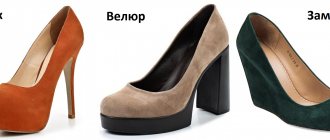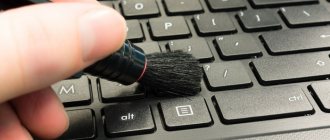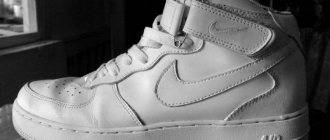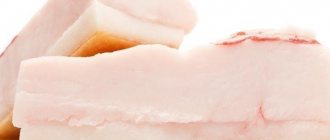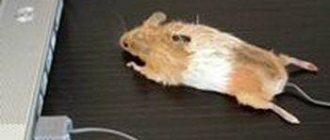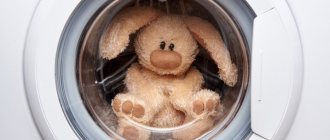09/12/201605/19/2017 Maria Ivanova 4 comments
The assortment of shoes includes thousands of types of models for all occasions. In addition to the obvious differences in styles, the models differ in the type of upper material.
Natural and artificial leather, polyester, leatherette, nubuck, suede, rubber - all kinds of materials are used by manufacturers to conquer the trade market.
Among summer models, shoes made from various types of fabric have not gone out of fashion for many years. Moccasins, clogs, sneakers, ballet flats, sandals, pantos, sneakers, shoes with fabric tops always look great.
White summer boots made of perforated fabric look very impressive. Consumers of all ages unconditionally fell in love with this type of footwear for a number of undoubted advantages:
- soft texture practically does not rub the skin of the feet in hot weather;
- the material provides ventilation for the shoes, the feet “breathe”;
- pleasant comfort when walking;
- The color range of the models makes it easy to choose clothes to match;
- fabric shoes are considered universal; they are used for sports, everyday activities, and going out.
The advantages of this type of shoe are obvious, but caring for them is also difficult. Leather shoes are easier to care for; they can be washed and cleaned in a matter of minutes with any detergent. Another thing is caring for fabric shoes.
Fabric moccasins, shoes and sneakers, despite their attractive appearance, instantly get dirty. In general, any fabric shoes must be carefully looked after. This is especially true for white shoes, let's be honest - such models are purchased only for one season.
If you wash and clean white shoes every day, then, despite careful care, they will invariably lose their original appearance. White sneakers or moccasins should be worn occasionally, as they say - on the boardwalk in dry weather.
General recommendations
Among the general rules for shoe care, we can highlight the use of only high-quality products, wearing boots only for their intended purpose, and the prohibition of removing a shoe by stepping on the heel. Care consists of 4 stages:
- cleaning;
- drying;
- cleaning;
- polishing and impregnation.
The first stage occurs after the person has gone home after a walk. Dirt remains on the shoes; in winter, these are reagents that are sprinkled on the streets. All this must be washed off within a few minutes. Otherwise, the frozen dirt will begin to be absorbed. If the dirt is small, it will be enough to go with a cloth or brush; large dirt can be cleaned with cold water.
The second stage is more often used in winter, autumn and spring, when the weather is chilly outside. There is no need to dry your shoes on a radiator or stove; just stuff your shoes with paper and leave them for a while. If the wetness is strong, then you need to wipe the boots dry with a soft cloth, fill them with paper and change it every two hours. Washing the inside is not recommended.
You need to clean it after drying, using gels and creams. Apply the product with a brush or sponge evenly over the entire surface. It will take 5-30 minutes for the cream to dry completely. Winter boots are cleaned every day. After using the cream several times, you need to wash your shoes with warm water and soapy water, which will wash away the old layers of the cream.
To make shoes shine, they need to be polished. Products used for polishing:
- soaked sponges;
- aerosols;
- wax;
- creams.
The product is applied to the shoe, it is polished using a natural bristle brush. A polishing cloth is then used. For perfect polishing, use a small amount of water, pour it onto the shoe and rub it over the surface in a circular motion. Impregnation is used to protect shoes from moisture.
Why is constant cleaning required?
Every day this part of the wardrobe is exposed to all sorts of external factors, including dust, dirt, and sudden changes in air temperature. Therefore, care will allow the material to last longer and maintain a presentable appearance.
Thanks to cleaning and washing, shoes:
- it is more difficult to pass moisture from the external environment;
- acquires dirt-repellent properties;
- looks like it was just purchased;
- It allows air to pass through better, making the wearer feel comfortable when wearing it;
- does not leave dust spots or streaks.
Manual cleaning of leather shoes
Proper care of leather shoes begins with the choice of cleaning products.
It is not the brand that should attract attention, but the composition. For example, wax protects from external influences and gives shoes shine, oils restore elasticity, silicone is used for polishing and creates a protective layer. You can clean leather shoes with a special brush, which can be artificial or natural. The hardness of the pile depends on the softness of the leather. The cream is applied with a brush-brush; you will also need a lint cloth and a polishing cloth.
Instructions for cleaning leather boots are as follows:
- Small dirt can be removed with a damp cloth. Heavily dirty shoes should be washed in soapy water using shampoo or cleaning foam.
- Dries naturally. It is prohibited to use various objects for drying. This will damage the shoes. For drying, special wooden blocks or paper are used.
- Leather shoes should be cleaned every day before going outside. Once a week the shoes are soaked and polished. The cream is applied with a soft sponge to the boots and left for 45 minutes. Residues are removed with a cloth.
- Water protection sprays are used: in dry weather - no more than 2 times a month; in rainy weather - before every exit.
- The final stage is polishing, for which a special napkin is used.
Caring for white leather boots has its own characteristics. Firstly, they must be stored separately from colored shoes. Secondly, separate brushes and clear (white) sprays are required for cleaning. White skin care is as follows:
- Remove dirt with a dry brush. Afterwards, the boots are wiped with a rag soaked in soapy water.
- The remaining powder is removed with warm water.
- The boots are wiped dry. If they are wet through, then paper is used for drying.
- White or transparent cream is applied to the brush and rubbed over the boot.
- The final stage is polishing. You can use velvet fabric.
You can clean white shoes with toothpaste. To preserve color, you can use a mixture of protein and milk.
Leather shoes with patent leather have the following care features:
- For daily cleaning, use soft sponges or cotton pads soaked in water. You can use milk.
- For polishing, products containing petroleum jelly, castor oil and glycerin are used.
- Creams and sprays must contain water.
If you properly care for shoes with patent leather, then cracks will not appear on their surface. To keep the glossy shine for a long time, you need to wipe your shoes with whipped egg white. The frequency of the procedure is once a month.
Washing issues
Cleaning, washing, polishing shoes with wax and other types of care largely depend on the type of product. Each material requires separate care.
Finished models
Products made from genuine leather are subjected to finishing processing. These are the majority of models on shoe store shelves. The treated skin looks smooth and shiny. It cannot be washed, but can only be wiped with a damp cloth or brush, first removing dust and dry dirt. If there are stains on the shoes, they can be removed with a brush dipped in a solution of vinegar and water mixed in equal parts.
Models without finishing
Cleaning models without treatment requires the same procedure. However, you can also use various chemicals that are not used when cleaning models with finishing treatment, so as not to damage the top layer. After all contaminants have been removed, the surface of the material can still be treated with special wax or oil.
Varnished models
Lacquered models require gentle care. Do not use rough brushes or cloths with hard bristles, as they will scratch the surface of the material. Patent leather shoes are cleaned with a damp sponge. After this procedure, the shoes are wiped dry and polished with a piece of velvet cloth.
Colored models
When caring for colored models, you should be careful and attentive using various cleaning products. They can ruin the paint of the material. Otherwise, cleaning such shoes is no different from caring for models made from the same material.
White models
For light-colored models, use a soft brush. A soft-bristled toothbrush can also help remove dirt. It gently removes external dirt. You need to make light, simple movements, press gently.
For cleaning you will need a cleaning solution. In a small bowl, mix warm water and a small amount of mild laundry detergent. The consistency should be slightly soapy, but not too foamy or sticky. When cleaning white models, it is important to avoid bleach as it can cause discoloration or damage to the material.
Using a soft cloth, apply the cleaning solution to the surface of the shoe using light circular motions. It is better to fill a second bowl with clean warm water to periodically rinse the fabric, avoiding dirt getting on the material.
When cleaning light-colored boots, boots, and other styles, it is important to completely remove all excess cleaning solution. To do this, take a clean soft cloth, lightly blot it in water and wipe the surface of the material. You do not need to completely immerse your shoes in water, as this may affect their shape. And the glue used in the design of some models does not react well to high levels of humidity.
Light-colored models are best air dried. It is worth choosing a cool and dry place, protected from direct sunlight. If your boots or boots get very wet while cleaning, you can fill them with paper towels to better maintain their shape as they dry.
Sneaker care
In dry weather, it is most convenient to wear sneakers or sneakers, which also need to be looked after.
4 steps apply here too. The first step is to unlace your sneakers. If the shoes are wet, dry them with paper or wooden blocks inside. Then you need to spray with a special deodorant to remove the smell. After which the standard cleaning procedure occurs. A common problem with sneakers is creases and wrinkles on the front surface. To give your shoes a new look, you need to smooth out all the bruises:
- Sneakers are tightly stuffed with paper and plastic bags.
- The surface of the sneaker and a cotton rag are moistened with water.
- The rag is placed on the shoe and ironed.
After these steps, the wrinkles will be smoothed out and the shoes will look like new.
Membrane type boots deserve special attention. The membrane protects the skin and ensures moisture evaporation. The material is used to create children's, sports, and hiking shoes. For cleaning, it is not recommended to use products that contain shoe polish. Sneakers are dried after each use. Impregnation with a water-repellent effect is applied to the surface.
How to properly care for your shoes
Even if you take care of your shoes, dust and dirt accumulate on them during everyday wear. You can purchase special aerosols for cleaning shoes in stores. It is important to select them according to the type of material from which the shoes are made.
And if the shoes are not only dirty, but also smell, then to get rid of the unpleasant odor, you can soak the insoles for an hour or two in a vinegar solution, which is quite easy to prepare. To do this you need to take 1 tbsp. l. vinegar and dilute with 1 glass of water.
The shoes themselves should be well ventilated in the fresh air and then wiped with a weak solution of potassium permanganate. To remove unpleasant odors, stores sell various deodorants, sprays, tablets, as well as insoles with special impregnation that prevent its appearance.
Inexpensive boots
Inexpensive boots are made from artificial leather. But even they need to be cleaned properly. Eco-leather shoes require the same care as boots made of genuine leather:
- remove dirt;
- dry;
- apply impregnation.
If the boots are very wet, they must be dried at room temperature until completely dry. Leather shoe products are used to remove stains. Leatherette boots are wiped with a damp cloth and dried at room temperature. Silicone is used to add shine. It is not recommended to clean with products that contain alcohol, fats, or acetone.
If you wash your shoes correctly, dry them, and clean them, you can extend their life by several years. Depending on the type of boots, the principle of care changes. But one thing remains unchanged - drying shoes on a radiator is prohibited. For these purposes, paper or special pads are used.
How to clean insoles in shoes
What a pair of boots can tell you
Shoes can tell something about their owner. The times when this piece of clothing served only as protection for the skin of the feet have sunk so deeply into oblivion that there are no sources left about them.
But evidence of customs adopted many thousands of years ago that have survived to this day states: both at the time of the Tower of Babel and in Ancient Egypt, shoes were a visible confirmation of a person’s status.
Luxurious sandals made of fine leather could only be worn by the nobility, while commoners were content with wooden clogs or bast shoes woven from wicker.
Currently, shoes can be used to judge both the status and character of their owner. The high cost of shoes is not the best indicator.
It is no secret that some millionaires prefer shoes from the most affordable brands, but less wealthy citizens often like to show off by dressing up in expensive shoes from well-known manufacturers. So you won’t surprise anyone with a loud brand.
People who know how to carefully care for their shoes and prolong their original shine for many years, regardless of the intensity of use, command much more respect.
Types of creams for smooth skin
Nourishes, refreshes color, gives natural shine. No silicone. It has the widest color palette - 102 shades.
Contains natural beeswax.
Nourishes, refreshes color, gives natural shine. No silicone. Easy to apply, has an applicator.
Color palette - 24 shades. Contains natural beeswax.
For final polishing. No silicone. Color palette - 6 shades.
Contains natural beeswax, carnauba wax and mineral wax.
Suede, nubuck and velor: similarities and differences in care
Suede, velor and nubuck are polished leather. These materials differ in the raw materials from which they are made and the tanning method.
Properties of suede, nubuck and velor
Velor is leather polished from the bakhtarma side (the lower surface of the dressed leather). Velor shoes have a sophisticated appearance, a velvety surface that is soft to the touch, and at the same time are known for their instability to water and dirt.
Velor has a rough surface texture
Nubuck is leather, polished on the front side. Nubuck is chrome-tanned leather that has been treated with an abrasive material. The result is the characteristic velvety surface of nubuck. This treatment gives the leather strength and breathability. Nubuck is made from cattle hides.
Nubuck has undeniable advantages: light structure and strength. Nubuck retains heat well and is often used for the production of winter shoes. Boots made from this material are comfortable even in the most severe frosts. Since it is a “breathable” material, summer shoes can also be made from nubuck.
The disadvantages of nubuck include difficulty in maintaining and intolerance to moisture.
There is also nubuck oil. This is a material with a special fat impregnation that prevents getting wet. It is not as velvety as regular one, but is more moisture resistant and durable.
Nubuck boots
Suede is leather made from selected raw materials, produced by fat tanning the skins of deer and small livestock. When making suede, the top layer, formed from dense fabric, is removed from the skin. During the dressing process, fats are introduced into the skin. The fat in suede chemically binds to the fibers, while in regular leather the fats are in an unbound state. As a result of fat tanning (“suedeing”), the leather becomes soft and water-resistant. Suede can be washed without deteriorating the properties of the leather.
Suede shoes
How to care for shoes made of suede, nubuck and velor after purchase
After purchasing shoes made of suede, velor or nubuck, you should not immediately leave the house in them. In order for shoes to look good for a long time, they should be protected from moisture and dirt.
After purchase, without delay, you need to impregnate it three times with a special spray. Care products for suede, velor, and nubuck are not cheap, but they are definitely necessary. You should buy spray and other care products at the same time as the shoes themselves. It is better to choose a spray from well-known, proven brands. Impregnation provides reliable protection against dirt and moisture. Water and dirt do not enter the fiber structure, but roll off the surface of the shoe. It remains “breathable”, its service life increases, and its appearance is preserved.
Spray for suede, nubuck and velor
Means and methods for cleaning shoes, boots and sneakers made of suede, nubuck and velor
Based on the properties of leather, wet cleaning methods can only be applied to suede.
Dry cleaning to remove dirt is most suitable for rough leathers. In this case, comfortable rubber brushes and hair brushes of different hardness are used.
It is important to use only high-quality and modern care products for suede, nubuck and velor. European brands have proven themselves well. Various sprays are available that restore the texture and color of rough skin.
Care products should be designed specifically for nubuck, suede and velor. Under no circumstances should you use cream or wax on smooth skin. This will lead to hopeless damage to the shoes.
Table: assessment of various methods and means of care
| Suede | Nubuck | Velours | |
| Wash | + | — | — |
| The washing up | + | — | — |
| Wet cleaning | + | — | — |
| Dry cleaning | + | + | + |
| Cream | Only use cream suitable for suede. | Only use cream suitable for nubuck. | Only use cream suitable for velor |
| Wax | — | — | — |
| Spray impregnation | + | + | + |
| Rubber brush | + | + | + |
| Classic brush with moderately hard bristles | + | — | + |
| Classic brush with soft bristles | + | + | + |
| Eraser | + | + | + |
Methods for cleaning dirt inside
External cleaning of products is carried out without any special difficulties, unlike internal ones. But treating the inside is just as important as the outside.
Recommendations for cleaning leather pairs inside:
- Carry out the procedure with an old toothbrush with hard bristles.
- Add a little washing powder to the water to improve cleaning.
- When carrying out the procedure, there is no need to be too zealous so as not to spoil the insole.
- Once a week, wipe the inner surface with an aqueous solution with the addition of ammonia (10 ml per 1 liter of water). This will help give the material shine.
- It is better to clean soft insoles with baby cream. Apply it to problem areas and rub in thoroughly. After 15-20 minutes, wipe off the residue with a cloth.
- It is better to clean the textile inner layer with shaving foam. It should be distributed evenly and rubbed with a brush in particularly dirty areas. After half an hour, remove the dirty foam with a dry cloth.
- You can get rid of stubborn stains only with the use of special cleaning products. After using them, soak the inside with baby cream.
By following these rules, cleaning the inside of your shoes will not be difficult. But this procedure should be carried out regularly so that the dirt does not have time to be absorbed into the structure of the material.
DIY painting
Manual cleaning of leather shoes, as well as restoration, is many times easier than that of fabric items. If the leather does not look as aesthetically pleasing as when purchased, then the following actions should be taken:
- if the skin has lost its shine, you need to use glycerin, colorless cream or Vaseline;
- if the shoes have lost their brightness of color, then you should apply one or two layers of dye and then dry thoroughly;
- if stains have become embedded in the surface of the skin, lemon juice, which should be soaked into a cotton pad before treatment, will help save the situation;
- for cracks or scratches, it is recommended to use liquid leather, having previously degreased the top layer;
- If a torn piece of leather is noticed on the product, it can be glued and then varnished over the surface.
Shoes are an integral attribute of a person’s image, and with careful care they can last for more than one season. In addition to daily care, it is important to pay attention to the general condition of the product, which will help to detect a problem in time and quickly fix it.
Rate this post

